Abstract
To determine the peripheral mechanisms involved in thermal sweating during the hot summers in July before acclimatization and after acclimatization in September, we evaluated the sweating response of healthy subjects (n=10) to acetylcholine (ACh), a primary neurotransmitter involved in peripheral sudomotor sensitivity. The quantitative sudomotor axon reflex test (QSART) measures sympathetic C fiber function after iontophoresed ACh evokes a measurable reliable sweat response. The QSART, at 2 mA for 5 min with 10% ACh, was applied to determine the directly activated (DIR) and axon reflex-mediated (AXR) sweating responses during ACh iontophoresis. The AXR sweat onset-time by the axon reflex was 1.50±0.32 min and 1.84±0.46 min before acclimatization in July and after acclimatization in September, respectively (p<0.01). The sweat volume of the AXR(1) [during 5 min 10% iontophoresis] by the axon reflex was 1.45±0.53 mg/cm2 and 0.98±0.24 mg/cm2 before acclimatization in July and after acclimatization in September, respectively (p<0.001). The sweat volume of the AXR(2) [during 5 min post-iontophoresis] by the axon reflex was 2.06±0.24 mg/cm2 and 1.39±0.32 mg/cm2 before and after acclimatization in July and September, respectively (p<0.001). The sweat volume of the DIR was 5.88±1.33 mg/cm2 and 4.98±0.94 mg/cm2 before and after acclimatization in July and September, respectively (p<0.01). These findings suggest that lower peripheral sudomotor responses of the ACh receptors are indicative of a blunted sympathetic nerve response to ACh during exposure to hot summer weather conditions.
REFERENCES
Bae JS., Lee JB., Matsumoto T., Othman T., Min YK., Yang HM. Prolonged residence of temperate natives in the tropics produces a suppression of sweating. Pflugers Arch-Eur J Physiol. 453:67–72. 2006.

Chemali KR., Gorodeski R., Chelimsky TC. Alpha-adrenergic supersensitivity of the sudomotor nerve in complex regional pain syndrome. Ann Neurol. 49:453–459. 2001.
Chen YW., Elizondo RS. Peripheral modification of thermoregulatory function during heat acclimation. J Appl Physiol. 37:367–373. 1974.

Cheuvront SN., Haymes EM. Ad libitum fluid intakes and thermoregulatory responses of female distance runners in three environments. J Sports Sci. 19:845–854. 2001.

Collins KJ., Weiner JS. Observations on arm-bag suppression of sweating and its relationship to thermal sweating “fatigue”. J Physiol London. 161:538–556. 1962.
Fox RH., Jack JW., Kidd DJ., Rosenbaum S. Observations in climatic chambers. Army Personal Research Committee. Med Res Coun, London, Ret. No. APRC 6, 25. 1962.
Horowitz M. Heat acclimation: A continuum of process. Mercer J, editor. ed,. Thermal Physiology. Elsevier Science Publishers B.V;Amsterdam: p. p. 445–450. 1989.
Kondo N., Shibasaki M., Aoki K., Koga S., Inoue Y., Crandall CG. Function of human eccrine sweat glands during dynamic exercise and passive heat stress. J Appl Physiol. 90:1877–1881. 2001.

Kondo N., Takano S., Aoki K., Shibasaki M., Tominaga H., Inoue Y. Regional differences in the effect of exercise intensity on thermoregulatory sweating and cutaneous vasodilation. Acta Physiol Scand. 164:71–78. 1998.

Kuno Y. Human Perspiration. Charles C Thomas Publisher, Springfield, Illinois. 1956.
Leblanc G., Landis SC. Development of choline acetyltransferase activity in the cholinergic sympathetic innervation of sweat glands. J Neurosci. 6:260–265. 1986.
Lee JB., Matsumoto T., Othman T., Kosaka M. Suppression of the sweat gland sensitivity to acetylcholine applied iontophoretically in tropical Africans compared to temperate Japanese. Trop Med. 39:111–121. 1997.
Lee JB., Othman T., Lee JS., Quan FS., Choi JH., Yang HM., Min YK., Matsumoto T., Kosaka M. Sudomotor modifications by acclimatization of stay in temperate Japan of Malaysian native tropical subjects. Jan J Tropical Medicine Hygiene. 30:295–299. 2002.

Lee JB., Bae JS., Lee MY., Yang HM., Min YK., Song HY., Ko KK., Kwon JT., Matsumoto T. The change in peripheral sweating mechanisms of the tropical Malaysian who stays in Japan. J Thermal Biol. 29:743–747. 2004.

Lee JB., Bae JS., Shin YO., Kang JC., Matsumoto T., Aliopv AT., Alipov G K., Kim WJ., Min YK., Yang HM. Long-term tropical residency diminishes central sudomotor sensitivities in male subjects. Korean J Physiol Pharmacol. 11:233–237. 2007.
Lee JB., Bae JS., Yang HM., Min YK. Tropical Malaysians and temperate Koreans exhibit significant differences in sweating sensitivity to iontophoretically administered acetylcholine. Int J Biometeorol. 52:Online 02 December,. 2008.
Low PA., Caskey PE., Tuck RR., Fealey RD., Dyck PJ. Quantitative sudomotor axon reflex test in normal and neuropathic subjects. Ann Neurol. 14:573–580. 1983.

Matsumoto T., Kosaka M., Yamauchi M., Tsuchiya K., Ohwatari N., Motomura M., Otomasu K., Yang GJ., Lee JM., Boonayathap U., Praputpittaya C., Yongsiri A. Study on mechanisms of heat acclimatization due to thermal sweating -Comparison of heat-tolerance between Japanese and Thai subjects. Trop Med. 35:23–34. 1993.
Matsumoto T., Taimura A., Yamauchi M., Lee JB., Kosaka M., Pongchaidecha A., Praputpittaya C., Gomonchareonsiri S., Boonayathap U., Sugenoya J. Long-term heat acclimatization in tropical inhabitants. Nielsen BJ, Nielsen R, editors. eds,. Thermal Physiology. Abstract. August Krough Institute;Copenhagen: p. p. 69. 1997.
Morris SJ., Shore A. Skin blood flow responses to the iontophoresis of acetylcholine and sodium nitroprusside in man: possible mechanism. J Physiol. 496:531–542. 1996.
Nadel ER., Pandolf KB., Roberts MF., Stojwijk JAJ. Mechanisms of thermal acclimation to exercise and heat. J Appl Physiol. 37:515–520. 1974.

Nielsen B. Heat acclimation-mechanisms of adaptation to exercise in the heat. Int J Sports Med Suppl. 2:S154–156. 1998.
Ogawa T., Asayama M., Miyagawa T. Effects of sweat gland training by repeated local heating. Jpn J Physiol. 32:971–981. 1982.

Ogawa T., Asayama M. Quantitative analysis of the local effect of the skin temperature on sweating. Jpn J Physiol. 36:417–422. 1986.
Ogawa T., Sugenoya J. Pulsatile sweating and sympathetic sudomotor activity. Jpn J Physiol. 43:275–289. 1993.

Onaka S., Hori S., Saito N., Shiraki K., Migasena P., Yoshihara H. The role of food habits in physiological adaptations of inhabitants of Southeast Asia to the habitat of tropical countries. Progr Hum Nutr. 2:219–235. 1978.
Pinnagoda J., Tupker RA., Agner T., Serup J. Guidelines for transepidermal water loss (TEWL) measurement. A report from the Standardization Group of the European Society of Contact Dermatitis. Contact Dermatitis. 22:164–178. 1990.
Robinson SM., Turrel ES., Belding HS., Hovath SM. Rapid acclimatization to work in hot climates. Am J Physiol. 140:168–176. 1953.

Sato F., Owen M., Matthes R., Sato K., Gisolfi CV. Functional and morphological changes in the eccrine sweat gland with heat acclimation. J Appl Physiol. 69:232–236. 1990.

Sato K., Dobson RL. Regional and individual variations in the function of the human eccrine sweat gland. J Invest Derm. 54:443–449. 1970.

Sato K., Sato F. Individual variations in structure and function of human eccrine sweat gland. Am J Physiol. 245:R203–R208. 1983.

Sawka MN., Coyle EF. Influence of body water and blood volume on thermoregulation and exercise performance in the heat. Exerc Sport Sci Rev. 27:167–218. 1999.
Sawka MN., Montain SJ., Latzka WA. Hydration effects on thermoregulation and performance in the heat. Comp Biochem Physiol A Mol Integr Physiol. 128:679–690. 2001.

Shibasaki M., Inoue Y., Kondo N., Iwata A. Thermoregulatory responses of prepubertal boys and young men during moderate exercise. Eur J Appl Physiol. 75:212–218. 1997.

Sugenoya J., Ogawa T., Jmai K., Ohnishi N., Natsume K. Cutaneous vasodilatation synchronize with sweat expulsions. Eur J Appl Physiol. 71:33–40. 1995.
Taylor NA. Eccrine sweat glands. Adaptations to physical training and heat acclimation. Sports Med. 3:387–397. 1986.
Tsujita J., Hori S. Comparative studies on sweating reflex, number of active sweat gland and body temperature of subtropical natives and temperate natives. Jpn J Trop Med Hyg. 6:157–165. 1978.
Vetrugno R., Liguori R., Cortelli P., Montagna P. Sympathetic skin response: basic mechanisms and clinical applications. Clin Auton Res. 13:256–270. 2003.
Vilches J., Navarro X., Verdu E. Functional sudomotor responses to cholinergic agonists and antagonists in the mouse. J Auton Nerv Syst. 55:105–111. 1995.

Weihe E., Tao-Cheng JH., Schafer MK., Erickson JD., Eiden LE. Visualization of the vesicular acetylcholine transporter in cholinergic nerve terminals and its targeting to a specific population of small synaptic vesicles. Proc Natl Acad Sci USA. 93:3547–3552. 1996.

Wilkerson WJ., Young RJ., Melius JM. Investigation of a fatal heatstroke. Am Ind Hyg Assoc J. 47:A493–A494. A496,. 1986.
Wyndham CH., Strydom NB., Munro A., Macpherson RK., Metz B., Schaff G., Schieber J. Heat reactions of Caucasians in hot dry and hot humid climates. J Appl Physiol. 19:607–612. 1964.
Wyndham CH. Effect of acclimatization on the sweat rate/rectal temperature relationship. J Appl Physiol. 22:27–30. 1967.

Yoshimura H. Acclimatization to heat and cold. Essential Problems in Climatic Physiology. Nankodo, Kyoto, p 61−106. 1960.
Fig. 1.
Monthly mean ambient temperatures in Cheonan (126 52'N, 33.38'E; Republic of Korea). Cheonan is located in a temperate zone, with cold winters and hot summers. The mean ambient temperature of the experimental period was −1.9°C in the winter (January) and 25.8°C in the summer (August) of 2007.
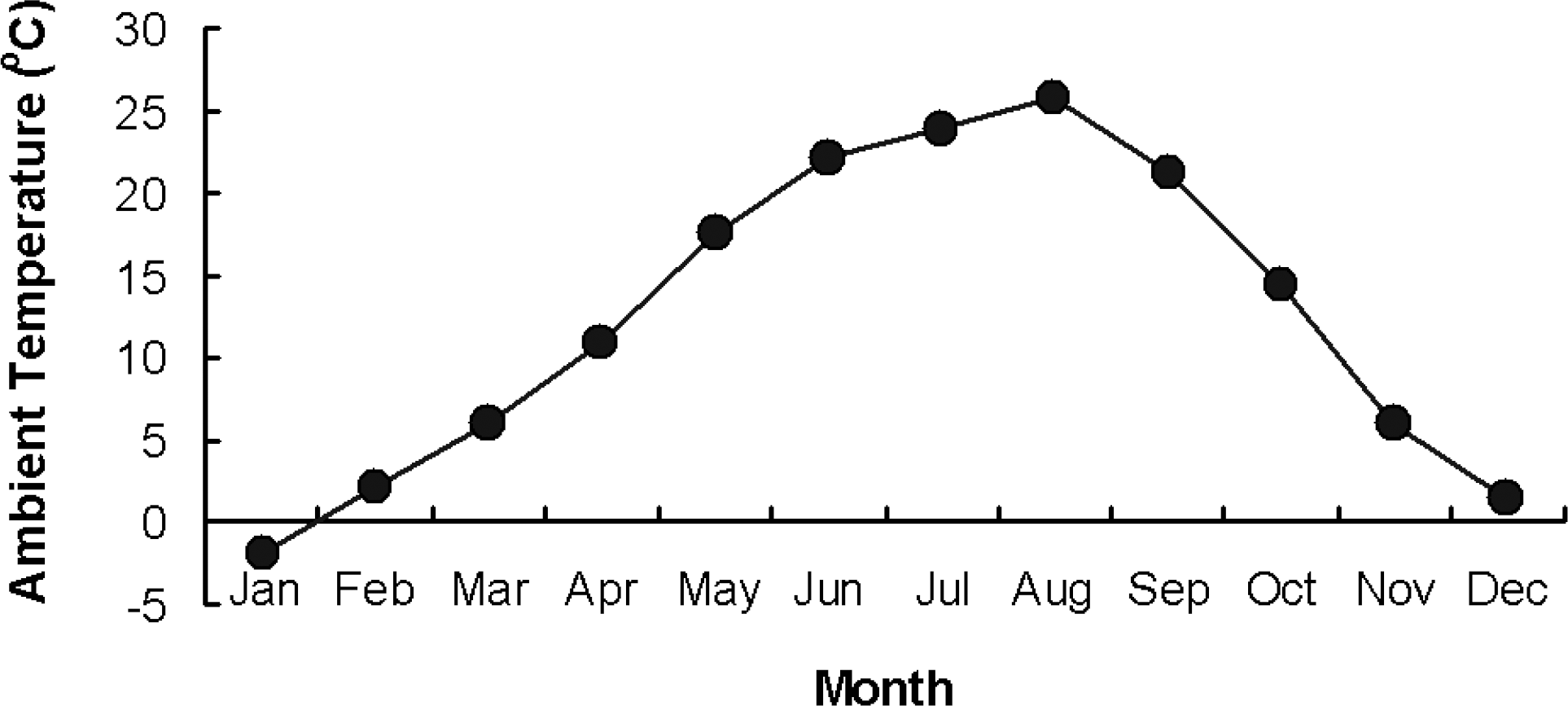
Fig. 2.
Sweat onset-time of axon reflex was 1.50±0.32 min and 1.84±0.46 min in human subjects before acclimatization in July and after acclimatization in September, respectively. The experimental period was during the hottest months of the summer (between July and August; Fig. 1). Values are presented as means (n=10)±SD. Statistical significance was set at p<0.001.
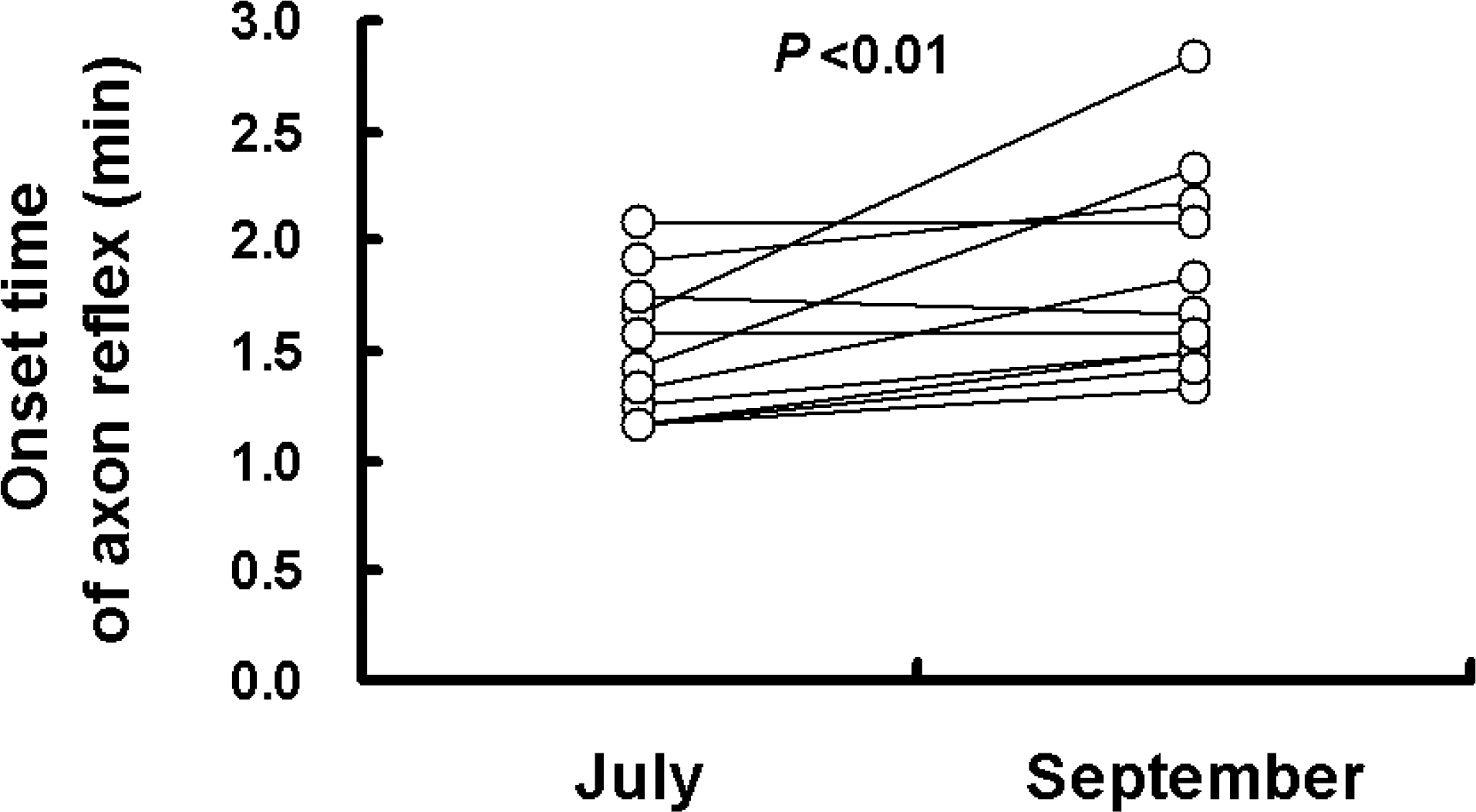
Fig. 3.
The AXR (1) sweat volume of the axon reflex was 1.46±0.53 mg/cm2 and 0.98±0.24 mg/cm2 in human subjects before acclimatization in July and after acclimatization in September, respectively. Comparison of the AXR (2) sweat volume of the axon reflex was 2.06±0.24 mg/cm2 and 1.39±0.32 mg/cm2 in human subjects before acclimatization in July and after acclimatization in September, respectively. AXR=axon reflex-mediated (indirectly activated) sweating during (nicotinic receptor-mediated sweating activity). AXR (1)=0~5 min and AXR (2)=6~11 min. Values are presented as means (n=10)±SD. Statistical significance was set at ∗∗∗p<0.001.
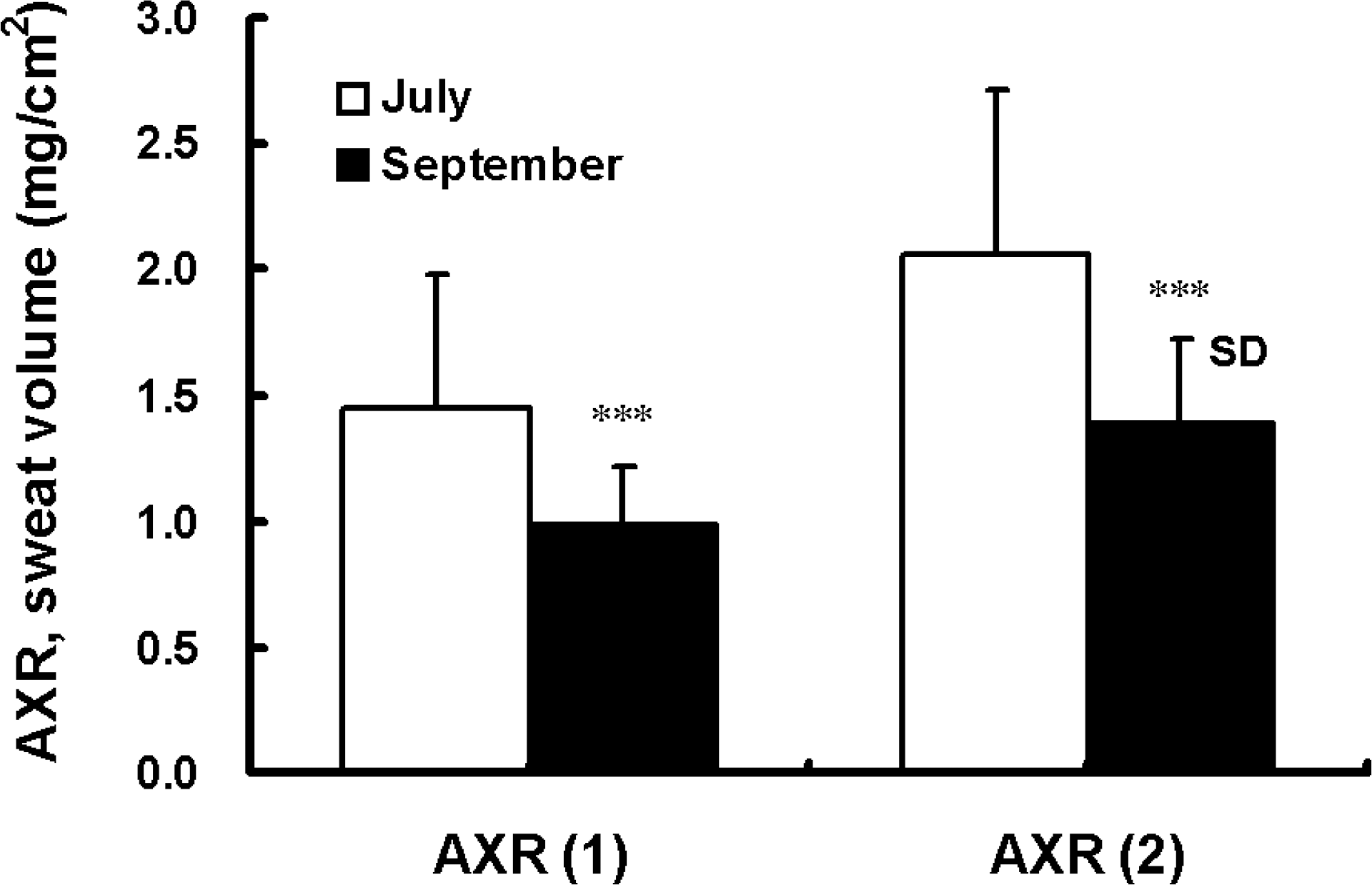
Fig. 4.
The DIR sweat volume (directly activated 6~11 min) was 5.88±1.33 mg/cm2 and 4.98±0.94 mg/cm2 in human subjects before acclimatization in July and after acclimatization in September, respectively. DIR=directly activated sweating during (muscarinic receptor-mediated sweating activity). Values are presented as means (n=10)±SD. Statistical significance was set at p<0.01.
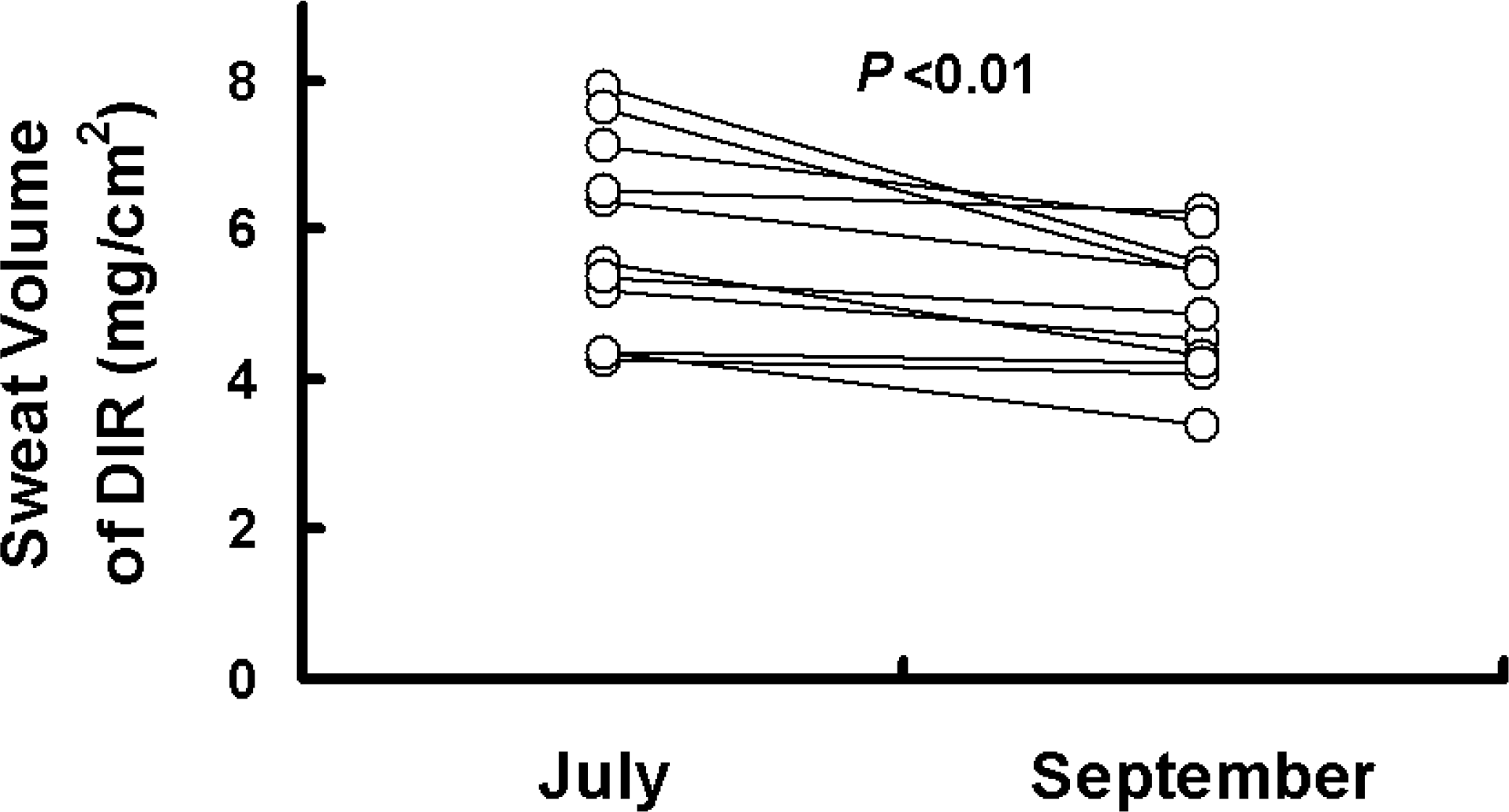
Fig. 5.
Sweating activity (forearm local skin evaporative loss volume) was 15.96±1.33 μg/cm2/min and 11.90±2.50 μg/cm2/min in human subjects before acclimatization in July and after acclimatization in September, respectively. Values are presented as the means (n=10)±SD. Statistical significance was set at ∗∗∗p<0.001.
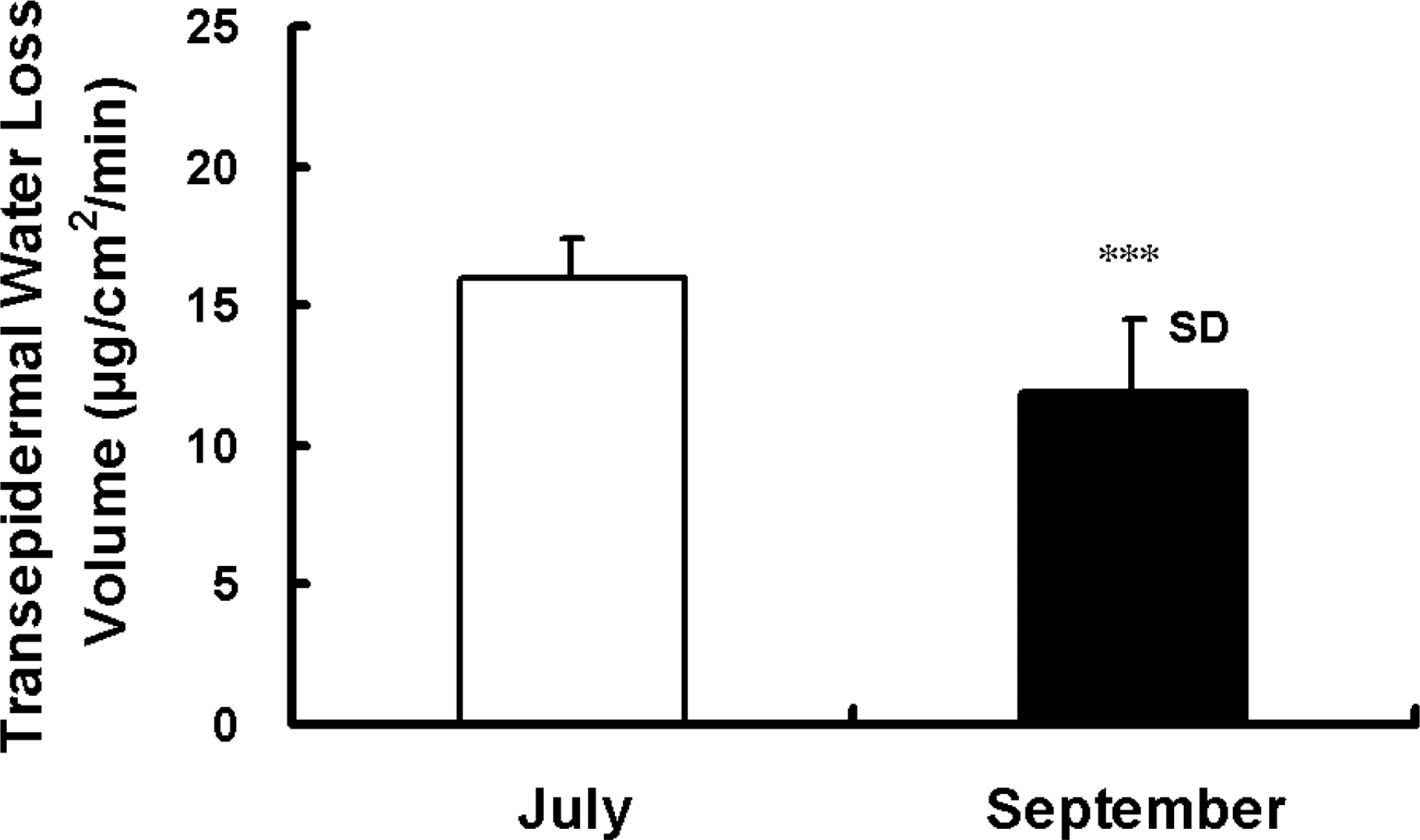




 PDF
PDF ePub
ePub Citation
Citation Print
Print


 XML Download
XML Download